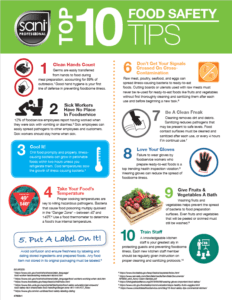Top 10 Food Safety Tips
A knowledgeable kitchen staff is your greatest ally in protecting guests and preventing foodborne illness
In today’s hyper-vigilant consumer environment, foodservice operators cannot afford a food safety slipup. Operators need to be sure their staff are following proper protocols and guests need to be confident that their choice of restaurant will not get them sick.
Much focus is being given to COVID-19 prevention, and rightfully so, but don’t lose sight of safe food handling practices. Proper storage, cooking, hand hygiene, and temperature control can ensure your guests have not only an enjoyable dining experience but a safe one as well.
Sani Professional’s Top 10 Food Safety Tips to keep you on the right path:
- Clean Hands Count – Germs are easily transferred from hands to food during meal preparation, accounting for 89% of all foodborne illness outbreaks.1 Good hand hygiene is your first line of defense in preventing foodborne illness.
- Sick Workers Have No Place in Foodservice – 12% of foodservice employees report having worked when they were sick with vomiting or diarrhea.2 Sick employees can easily spread pathogens to other employees and customers. Sick workers should stay home when sick.
- Cool It! – Chill food promptly and properly. Illness causing bacteria can grow in perishable foods within two hours unless you refrigerate them. Cold temperatures slow the growth of illness causing bacteria.3
- Take Your Food’s Temperature – Proper cooking temperatures are key to killing hazardous pathogens. Bacteria that cause food poisoning multiply quickest in the “Danger Zone” – between 40˚ and 140˚F.4 Use a food thermometer to determine a food’s true internal temperature.
- Put a Label on It! – Avoid confusion and ensure freshness by labeling and dating stored ingredients and prepared foods. Any food item not stored in its original packaging must be labeled.5
- Don’t Get Your Signals Crossed on Cross-Contamination – Raw meat, poultry, seafood, and eggs can spread illness-causing bacteria to ready-to-eat foods. Cutting boards or utensils used with raw meats must never be re-used for ready-to-eat foods like fruits and vegetables without first thoroughly cleaning and sanitizing them after each use and before beginning a new task.6
- Be A Clean Freak – Cleaning removes dirt and debris. Sanitizing reduces pathogens that may be present to safe levels. Food contact surfaces must be cleaned and sanitized after each use, or every 4 hours if in continual use.7
- Love Your Gloves – Failure to wear gloves by foodservice workers who prepare ready-to-eat foods is a top trending health inspection violation.8 Wearing gloves can reduce the spread of foodborne illness.
- Give Fruits & Vegetables a Bath – Washing fruits and vegetables helps prevent the spread of bacteria to food preparation surfaces. Even fruits and vegetables that will be peeled or skinned must still be washed.9
- Train Staff – A knowledgeable kitchen staff is your greatest ally in protecting guests and preventing foodborne illness. Each new kitchen staff member should be regularly given instruction on proper cleaning and sanitizing protocols.10
Keep these tips handy for your staff – download our Top 10 Food Safety Tips training poster:

Sources:
- https://www.cdc.gov/nceh/ehs/ehsnet/plain_language/food-worker-handwashing-restaurant-factors.htm
- https://www.cdc.gov/nceh/ehs/ehsnet/plain_language/food-workers-working-when-sick.htm
- https://www.foodsafety.gov/keep/basics/chill/index.html
- https://www.fsis.usda.gov/wps/portal/fsis/topics/food-safety-education/get-answers/food-safety-fact-sheets/safe-food-handling/danger-zone-40-f-140-f/CT_Index
- https://www.gfs.com/en-us/ideas/food-safety-labeling-dating
- https://www.foodsafety.gov/keep/basics/separate/index.html
- https://www.servsafe.com/ServSafe/media/ServSafe/Documents/NFSEM_wk3_Actvy-Clean-Sanitize.pdf
- https://diningsafetyalliance.org/2018/05/08/wearing-gloves-important-food-safety/
- https://www.cdc.gov/foodsafety/communication/steps-healthy-fruits-veggies.html
- https://www.consolidatedfoodservice.com/blog/10-food-safety-tips-commercial-kitchen/

